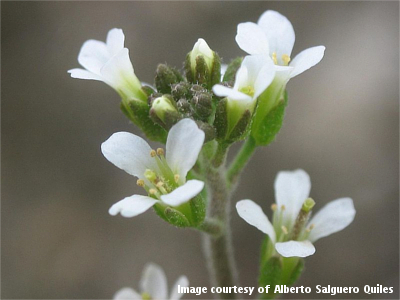GARNet explain why a weedy relative of mustard is so important
Posted on 12 April 2013
GARNet explain why a weedy relative of mustard is so important
 By Charis Cook, GARNet.
By Charis Cook, GARNet.
GARNet is the UK Arabidopsis research network. You can be forgiven for not having heard of Arabidopsis thaliana (pictured right) before, as it is a weedy relative of mustard, also known as the humble thale cress.
So why, why, is there a network for A. thaliana researchers? Well, in practice we work with plant scientists of all kinds – but of course there is a reason why we still focus on this one little plant.
The magic of cress
A. thaliana has been the plant of choice for plant genetic studies for decades, but when A. thaliana became the first plant to have its genome sequenced in 2000, its status as the model plant was cemented.
This means nearly every web database, analysis tool, or software used in plant science was built for A. thaliana first. Indeed, the first plant genome-wide association study started in 2008 and is still on-going and using natural Arabidopsis varieties. In fact, it’s likely that Arabidopsis researchers will be the first to try synthetic biology in higher plants. (For those interested in further reading, I’ve provided a list of online resources.)
The research landscape is changing, but A. thaliana is still the major plant used in plant science for blue-skies research, and is often the starting point for projects with an intended commercial application too. GARNet supports basic research and the researcher at the individual lab level, so it is natural that we focus on Arabidopsis.
What GARNet does
We help plant researchers network with each other, funding agencies, and the wider scientific research community. Our day-to-day activities are managing our open-to-all mailing list, our website and blog, and twice-annual newsletter. Beyond these day-to-day communication platforms our activities are steered by a committee of elected members from the plant research community.
We organise two (or more) meetings each year, usually with the objective of introducing researchers to a new idea or method. Our meetings this year are An Introduction to Opportunities in Plant Synthetic Biology, and a training workshop on bioinformatics and data analysis, for which we are currently assembling the programme with the help of community feedback. We also run workshops to discuss matters of importance to the plant science community, and report on the conclusions to policy-makers and funders. For example, the report from last year’s Making Data Accessible to All workshop on open-data policies was released in July 2012, and a paper will be published shortly on it.
Software in bloom
Plant researchers rely on software to do their research. Sequencing methods now generate all sorts of data, from basic DNA sequences to gene expression datasets or locations of epigenetic modification. This data and much more is used to model anything from molecular pathways to whole plant responses to stress. Furthermore, many tools are available online, but some groups build their own databases to store and analyse data (like PRESTA and Gramene, or, for microbiologists, SysMo DB).
Some plant research groups include expert programmers, but others depend on collaborations or use pre-existing tools for their work. The many training events for scientists at TGAC and EBI and one-off events like ours, are a testament to the desire among the traditional research community to learn more. So please treat your friendly local plant scientist kindly if they ask you for some input!
GARNet is funded by the Biotechnology and Biological Sciences Research Council.
